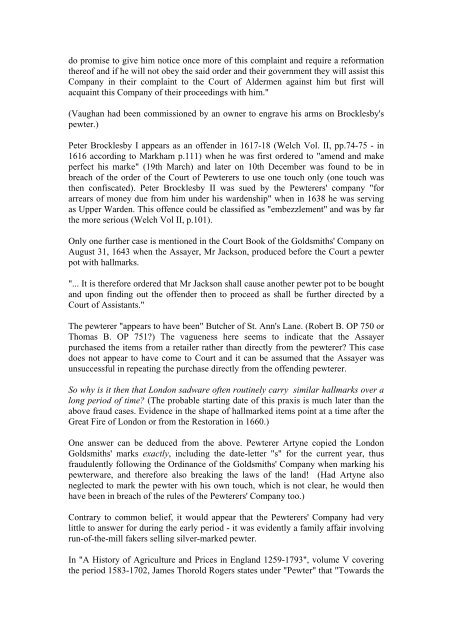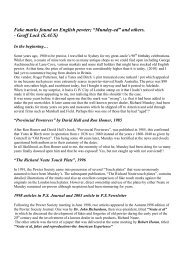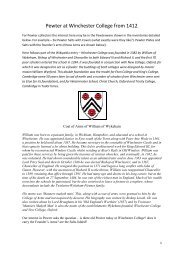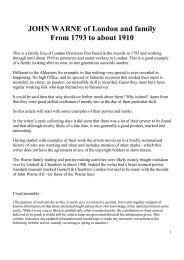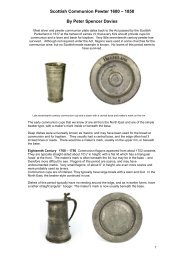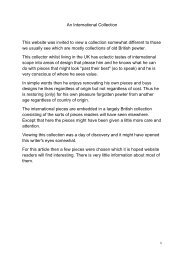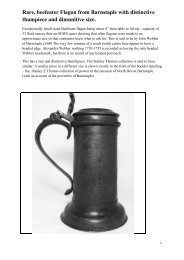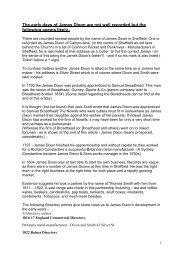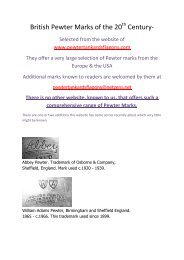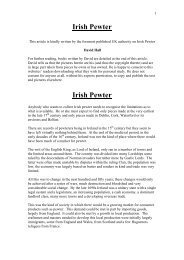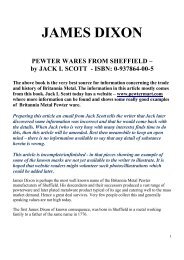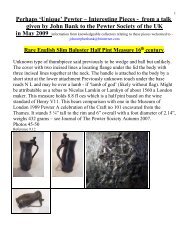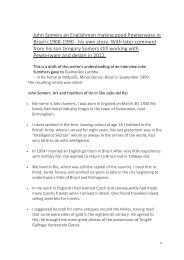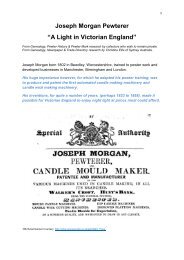Hallmarks - fake and pseudo silver marks on pewter in ... - PewterBank
Hallmarks - fake and pseudo silver marks on pewter in ... - PewterBank
Hallmarks - fake and pseudo silver marks on pewter in ... - PewterBank
You also want an ePaper? Increase the reach of your titles
YUMPU automatically turns print PDFs into web optimized ePapers that Google loves.
do promise to give him notice <strong>on</strong>ce more of this compla<strong>in</strong>t <str<strong>on</strong>g>and</str<strong>on</strong>g> require a reformati<strong>on</strong><br />
thereof <str<strong>on</strong>g>and</str<strong>on</strong>g> if he will not obey the said order <str<strong>on</strong>g>and</str<strong>on</strong>g> their government they will assist this<br />
Company <strong>in</strong> their compla<strong>in</strong>t to the Court of Aldermen aga<strong>in</strong>st him but first will<br />
acqua<strong>in</strong>t this Company of their proceed<strong>in</strong>gs with him."<br />
(Vaughan had been commissi<strong>on</strong>ed by an owner to engrave his arms <strong>on</strong> Brocklesby's<br />
<strong>pewter</strong>.)<br />
Peter Brocklesby I appears as an offender <strong>in</strong> 1617-18 (Welch Vol. II, pp.74-75 - <strong>in</strong><br />
1616 accord<strong>in</strong>g to Markham p.111) when he was first ordered to "amend <str<strong>on</strong>g>and</str<strong>on</strong>g> make<br />
perfect his marke" (19th March) <str<strong>on</strong>g>and</str<strong>on</strong>g> later <strong>on</strong> 10th December was found to be <strong>in</strong><br />
breach of the order of the Court of Pewterers to use <strong>on</strong>e touch <strong>on</strong>ly (<strong>on</strong>e touch was<br />
then c<strong>on</strong>fiscated). Peter Brocklesby II was sued by the Pewterers' company "for<br />
arrears of m<strong>on</strong>ey due from him under his wardenship" when <strong>in</strong> 1638 he was serv<strong>in</strong>g<br />
as Upper Warden. This offence could be classified as "embezzlement" <str<strong>on</strong>g>and</str<strong>on</strong>g> was by far<br />
the more serious (Welch Vol II, p.101).<br />
Only <strong>on</strong>e further case is menti<strong>on</strong>ed <strong>in</strong> the Court Book of the Goldsmiths' Company <strong>on</strong><br />
August 31, 1643 when the Assayer, Mr Jacks<strong>on</strong>, produced before the Court a <strong>pewter</strong><br />
pot with hall<str<strong>on</strong>g>marks</str<strong>on</strong>g>.<br />
"... It is therefore ordered that Mr Jacks<strong>on</strong> shall cause another <strong>pewter</strong> pot to be bought<br />
<str<strong>on</strong>g>and</str<strong>on</strong>g> up<strong>on</strong> f<strong>in</strong>d<strong>in</strong>g out the offender then to proceed as shall be further directed by a<br />
Court of Assistants."<br />
The <strong>pewter</strong>er "appears to have been" Butcher of St. Ann's Lane. (Robert B. OP 750 or<br />
Thomas B. OP 751) The vagueness here seems to <strong>in</strong>dicate that the Assayer<br />
purchased the items from a retailer rather than directly from the <strong>pewter</strong>er This case<br />
does not appear to have come to Court <str<strong>on</strong>g>and</str<strong>on</strong>g> it can be assumed that the Assayer was<br />
unsuccessful <strong>in</strong> repeat<strong>in</strong>g the purchase directly from the offend<strong>in</strong>g <strong>pewter</strong>er.<br />
So why is it then that L<strong>on</strong>d<strong>on</strong> sadware often rout<strong>in</strong>ely carry similar hall<str<strong>on</strong>g>marks</str<strong>on</strong>g> over a<br />
l<strong>on</strong>g period of time (The probable start<strong>in</strong>g date of this praxis is much later than the<br />
above fraud cases. Evidence <strong>in</strong> the shape of hallmarked items po<strong>in</strong>t at a time after the<br />
Great Fire of L<strong>on</strong>d<strong>on</strong> or from the Restorati<strong>on</strong> <strong>in</strong> 1660.)<br />
One answer can be deduced from the above. Pewterer Artyne copied the L<strong>on</strong>d<strong>on</strong><br />
Goldsmiths' <str<strong>on</strong>g>marks</str<strong>on</strong>g> exactly, <strong>in</strong>clud<strong>in</strong>g the date-letter "s" for the current year, thus<br />
fraudulently follow<strong>in</strong>g the Ord<strong>in</strong>ance of the Goldsmiths' Company when mark<strong>in</strong>g his<br />
<strong>pewter</strong>ware, <str<strong>on</strong>g>and</str<strong>on</strong>g> therefore also break<strong>in</strong>g the laws of the l<str<strong>on</strong>g>and</str<strong>on</strong>g>! (Had Artyne also<br />
neglected to mark the <strong>pewter</strong> with his own touch, which is not clear, he would then<br />
have been <strong>in</strong> breach of the rules of the Pewterers' Company too.)<br />
C<strong>on</strong>trary to comm<strong>on</strong> belief, it would appear that the Pewterers' Company had very<br />
little to answer for dur<strong>in</strong>g the early period - it was evidently a family affair <strong>in</strong>volv<strong>in</strong>g<br />
run-of-the-mill <str<strong>on</strong>g>fake</str<strong>on</strong>g>rs sell<strong>in</strong>g <str<strong>on</strong>g>silver</str<strong>on</strong>g>-marked <strong>pewter</strong>.<br />
In "A History of Agriculture <str<strong>on</strong>g>and</str<strong>on</strong>g> Prices <strong>in</strong> Engl<str<strong>on</strong>g>and</str<strong>on</strong>g> 1259-1793", volume V cover<strong>in</strong>g<br />
the period 1583-1702, James Thorold Rogers states under "Pewter" that "Towards the


